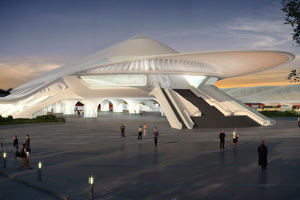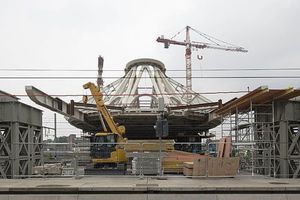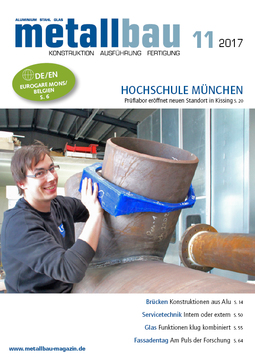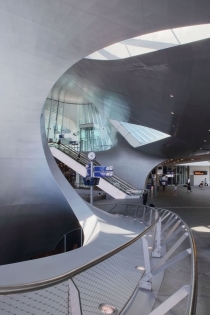A nave over the rails
The Star Architect, Santiago Calatrava, is currently building a new Main Railway Station in the Belgian town of Mons. The steel construction of the cathedral-like Railway Station Hall, spanning the rails, is currently being constructed next to the rail lines and being shifted over the continually in-use railway lines in seven separate batches.
The new railway station will be a centrepiece of urban planning, standing on the same site as its predecessor (a temporary measure to its side replaces it at the moment), which is to connect the Centre lying to the south-east of the lines with a city extension, currently emerging north-west of the rails.
This one-day enclosed structure possesses an elongated interior, whose sides are divided into ten bays and is being topped off with a span roof open top to bottom. It recalls a Roman Basilica, therefore also the nave of a church. The 165.5 m long, 14.7 m wide and 15.8 m high space is to serve in future not only as a connecting bridge, but also as a 4,740 m² size Shopping Mall. The build will be book-ended on both sides with large open staircases, over which two respective 31 m projecting canopies will stretch.
Five “platforms” lead off from the side. This term is in Quotation Marks, as only three of them lead to the lines, the two others on the other hand towards the Bus Station, which is being established directly adjacent to the lines.
While the hall construction in terms of the five “platforms” is being borne without any problems by up to 4.5 tonne heavy, mostly made of massive steel, cylindrical columns, this is not possible on the north-western side. Here the completion of the station will see a new track ladder for the parking of trains. The hall will span 70 m here without any supports.
Smooth transition
The hall construction is built purely of steel, which is divided into different building sections and is currently being completed by five separate steel construction firms. In this process the hall is being assembled on the brownfield site bay by bay to the north-west of the rails. Nevertheless, if the north-western boundary of the construction site is reached, the entire construction will be shunted on slide bearings for about 16 m further over the rails. So that would make more space to start another bay.
The first unit was the one with the greatest space, it encompassed five bays as well as the south-eastern end of the hall, the Choir of the basilica, if you will. Not yet assembled is the canopy belonging to it; this will happen after achieving the final hall position. Logistical considerations led to the rhythm of two bays alternating with a single one being set. There will be a total of seven phases, until the hall reaches its final state.
To aid the forwards movement, the whole steel structure rests on temporary bearings, its permanent position in relation to the platforms will take some time. Twelve temporary bearings, six for each of the two main beams, which will remain, will carry the steel construction during the shell building phase. At the moment the construction rests on only four.
The meantime insolvent steel building company, Cordioli - which was initially commissioned to produce the entire steel construction - decided that propulsion of the Hall construction was to be done upon Teflon bearings and not upon rollers. In justification of its decision, it pointed towards that, as far as a Teflon layer guides a stainless steel joist joined to a bottom boom, the friction tolerance would only be 5% and that this lateral force is insufficient to guarantee the structural integrity of the supports.
The propulsion is achieved by means of two hydraulic cable pull systems, which were each placed under the main girders, which “reach” towards cable bands grouped into round bundles and have traction per cylinder hub of around 20 cm. During the pulling manoeuvre, one can see that this cylinder is slowing moving out and in this way is pulling the entire steel construction over it. After perhaps 4 minutes, the mechanism reaches its maximum displacement, the cable releases itself from its embrace and the hydraulics retract again for their next pull. An interim temporary elongation of the cable during the traction procedure does not appear to be a great issue.
The cable band is repeatedly replaced at the end of the respective end of the shell building construction, the traction mechanism remains at rest during the entire building process. In this respect, with each of the seven pulls, the same, perhaps 25m long cable pairs, are repeatedly pulled through.
Shell Building Construction
The ten side bays and also the three respective choir bays to the sides are assembled on-site, as they are far too large for any Heavy Transporter. The assembly of the segments is performed while laid out on the ground and is reminiscent of a carpenter’s curing area for wooden roof trusses. Some areas of these elements possess small corrugated iron enclosures, which enable the metal workers to undertake extensive welding irrespective of the weather. With a heavy building crane and an automated crane with an extra long arm, the buidling components are finally lifted into their intended position.
Until their load-bearing welding, the individual, tapered bay elements lie temporarily upon an at least 14 m high interior steel frame, that at the axis of the hall construction may be guided along rails. High above, there is a large working area, which enables the metal constructors precisely to weld together the individual sections of the bay and particularly the upper belt subsequently laid upon it, which runs to the end. In this process, every completed welding seam is checked by a technician for its electrical conductivity, in order to identify welding failures at an early stage.
While in relation to the lower belt, the hall construction immediately underneath the future flooring is being worked on with screw fittings, in relation to the upper belt and the one continuous ridge line, a fusing of materials by welding is taking place. To these are temporarily fixed the upper belt elements lifted by crane with respective 2 cm thick fishplates. For the element joints, the engineers have provided generous folded edges or notches, which from now on produce joints, which have an average size of 3 x 3 cm. This the welder must now completely fill with material and afterwards process tidily. In this he also removes the impressively large temporary brackets. The welding in relation to the ridge line is left till later on.
Underneath the floor there will be a cavity, which will also be lined with sheet metal. These spaces, which are accessible through service hatches, will carry all the building services along pipeline routes. So the local bolts will also not be visible any more; while the entire steel construction of the roof from a low angle is open.
Movements in numbers
The bottom chord or main girder is 1,400 mm high and has a width of 800 mm, its flange thickness varies between 30 and 80 mm. This is on one hand based upon the varying loads, which have been introduced into the construction, and on the other, due to the planned pre-stressing. It is necessary, in relation to the future track ladder, to clear-span the whole construction of over 70 m. As a result of the planned clear span and the loads not yet brought into this build phase, the beam possesses a S shape not perceptible to the human eye; it has, however, been a factor in the construction of the temporary slide bearing. The temporary support units additionally demonstrate a sideways control mechanism, which avoids a “collapse” of the steel construction. Horizontal movement will be carried out somewhat above the final position. In this way the construction can be shifted over the final steel cylindrical supports and the already erected platform staircases made of concrete without any problems. Once arrived at the final position, the entire steel construction will be lowered precisely in one manoeuvre.
The Hall Construction will have a total weight of 6,000 tonnes, the maximum shifted weight, however, accounts for “only” 4,300 tonnes. During the steel construction phase, on grounds of weight, the installation of a final base plate will not go ahead. At the moment, this only consists of trapezoidal plates, which shall serve only once as a formwork. After arrival into the final hall position, a steel reinforcement will be laid upon it and then covered in cast-in-place concrete.
The whole facade construction will also begin at the final position. It was considered too great a risk, as otherwise pieces of the roof surface at over 30,000 m² might warp and could cause the glazing to blow out.
Underground
The future platform staircases were in fact the first to be constructed for the railway station two years ago. They consist, exactly like the extended lower ground area of the new railway station on both sides of the rails, overwhelmingly of precast concrete. They will serve one day principally as car parks with respectively approximately 600 parking spaces. The expressive stylistic idiom of the elements is reminiscent of the Multi-storey car park or Sloping Construction of the new railway station completed in 2009 at Lüttich, which was another Calatrava build.
One interesting aspect of Mons is that on the ceiling of the underground car park, which was completed first, the Building Crane, as well as the bearings and the traction hydraulics of the hall construction, were situated. This ceiling is of course not designed for the resulting additional loads, so on the lower ground level, directly beneath, a temporary forest of steel stanchions was set up.
No dragon
Calatrava’s very first model for the new railway station in Mons was already playing with the idea of a Shopping Mall, yet he also envisaged an additional pylon at one end. Along with this, he wanted to reference dragons, as this mythical creature has dedicated to it annually the popular festival of the “Doudou”, which is recognised as a Masterpiece of the Oral and Intangible World Heritage of Humanity by UNESCO. In fact, the pylon fell victim to cuts and of the dragon, which the Fraternity of St George 1380 want to have slain here, remained only a rump and - depending on your point of view - an open mouth, into which you can certainly plunge oneself some time after 2019.
Metal Yapi
The Turkish Steel Construction firm of Steel Yapi was founded over 50 years ago and is managed today by joint CEOs, Selami Gürel and Özgül Bulent. Gürel holds himself more responsible for planning and Bulent more for the commercial aspect.
The most noteworthy construction of the business until now is the Sir Norman Foster designed, multi-functional “Khan Shatyr” Events Centre in the Kazakh Capital of Astana. The international set-up of the business covers all aspects of Steel Construction, from the purchasing and processing, up to the installation. From its own figures, the business erects annually 300,000 m² of facade surfacing and processes 20,000 tonnes of steel. Annual turnover is in the order of 150m USD. Its core competence lies in its business of 800 employees, of whom over 100 are Engineers, principally in Facade Construction and in the creation of design-oriented structures.
For the Eurogare Railway Station project at Mons in Belgium, the business’s services include the relocation construction of the Hall , the pre-production of the Hall Segments at their factory, their delivery, their joining together as well as their installation, temporary fixation and final welding together. The Project Manager responsible for the Calatrava build at Metal Yapi, Uraz Polat, places emphasis upon the declaration that the relocation of the body of the Hall onto Teflon bearings for this project was in fact started by the previous contractor, Cordioli, and is now being continued by Metal Yapi, but this has long been established construction technique.
For the Railway Station project in Mons, Metal Yapi is not the sole active firm, yet its Engineers are involved in the planning of this build in all aspects of set-up, lifting and positioning of the large Hall components. For instance, they successfully championed, that the 3 x 3 cm large welding joints were sealed by arc welding most effectively using cored wire electrode. The steel used was partially sourced from the main contractor, but it was also purchased in part directly from Metal Yapi. The steel elements were previously delivered only by lorry.
Before its commissioning as Leading Metal Construction business for this project, the Turkish firm was already involved here as a solution partner and subcontractor for CTI Blaton. This internationally active firm is currently working on projects in the United Kingdom, Ireland, Germany, France, Belgium and Romania.
www.metalyapi.com




